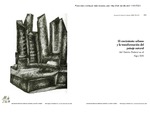Mostrar el registro sencillo del ítem
El crecimiento urbano y la transformación del paisaje natural del Distrito Federal en el Siglo XIX
| Autor: | Contreras Servín, Carlos |
| Autor: | Galindo Mendoza, María Guadalupe |
| Fecha de publicación: | 2008 |
| URI: | http://hdl.handle.net/11191/7221 |
| Resumen: | El deterioro del medio físico que vive actualmente el Distrito Federal, tiene su origen en el siglo XIX. Demostrar esta hipótesis, es la finalidad de este artículo. El planteamiento que generó el proceso de investigación, surgió a partir de la idea de que, si bien es cierto, que desde la época Colonial, la zona aledaña a la Ciudad de México ha sufrido un continuo cambio en el paisaje; es, sin embargo, la dimensión que alcanza la destrucción de los recursos naturales en el siglo diecinueve, lo que va a determinar que en esta entidad, al finalizar dicho siglo, desaparezca para siempre el paisaje natural que existió un día en este lugar. Sobre el punto anterior, conviene aclarar que a partir del año de 1824 se forma el Distrito Federal como tal; el cual fue modificando sus límites hasta establecer, en el año de 1899, su extensión territorial definitiva. Por este motivo, los estudios que en el pasado hacen alusión a la zona, se refieren al Valle de México o a la Ciudad de México. Posteriormente, el incremento en el número de habitantes del Distrito Federal en las últimas décadas del siglo XIX, trajo como resultado la expansión de la mancha urbana la cual, a su vez, modificó el paisaje natural del Valle de México. El eje central de este proceso urbano, lo constituyó la Ciudad de México y las poblaciones aledañas como Tacuba, Popotla, Tacubaya y la V illa de Guadalupe; pero también se da un importante crecimiento en los pueblos de San Ángel, Coyoacán, San Agustín de las Cuevas (hoy Tlalpan) y Xochimilco. |
| Resumen: | The deterioration of the physical environment that is currently living the Federal District, has its origins in the nineteenth century. Prove this hypothesis, is the purpose of this article. The approach that generated the research process, originated from the idea that, while it is true that since the Colonial era, the area near the Mexico City has suffered a continuous change in the landscape, however the dimension that is the destruction of natural resources in the nineteenth century, which will determine that this entity, by the end of this century, will disappear forever the natural landscape that existed one day in this place. On the previous point, it is clear that from the year 1824 is formed such as the Federal District, which was amended to establish its limits, in the year 1899, its final extension. For this reason, studies in the past refer to the area, refer to the Valley of Mexico or Mexico City. Subsequently, the increase in the number of inhabitants of the Federal District in the last decades of the nineteenth century, resulted in the expansion of the urban area which, i.n turn, changed the landscape of the Valley of Mexico. The centerpiece of this city, was the Mexjco City and the neighboring localities as Tacuba, Popotla, Tacubaya and Villa de Guadalupe, but there is also a significant growth in the villages of San Angel, Coyoacán, of San Agustín de las Cuevas (today Tlalpan) and Xochimilco. |
| Formato: | |
| Idioma: | spa |
| Editor: | Universidad Autónoma Metropolitana (México). Unidad Azcapotzalco. |
| Fuente: | Anuario de Espacios Urbanos, Historia, Cultura y Diseño 2008, no. 15 (enero-diciembre de 2008), ISSN 2448-8828. |
| Materias: | HUMANIDADES Y CIENCIAS DE LA CONDUCTA::CIENCIAS DE LAS ARTES Y LAS LETRAS::ARQUITECTURA::URBANISMO |
| Clasificación LC: | F1386.3 |
| Materias: | Urbanization--Mexico--Mexico City--History--19th century. |
| Materias: | Urbanización. |
| Materias: | Ciudad de México -- Historia. |
| Título: | El crecimiento urbano y la transformación del paisaje natural del Distrito Federal en el Siglo XIX |
| Tipo de publicación: | Artículo |
| Origen del formato: | Reformatted digital |



